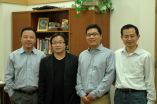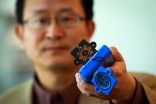(Press-News.org) If you can uniformly break the symmetry of nanorod pairs in a colloidal solution, you're a step ahead of the game toward achieving new and exciting metamaterial properties. But traditional thermodynamic -driven colloidal assembly of these metamaterials, which are materials defined by their non-naturally-occurring properties, often result in structures with high degree of symmetries in the bulk material. In this case, the energy requirement does not allow the structure to break its symmetry.
In a study led by Xiang Zhang, director of Berkeley Lab's Materials Sciences Division, he and his research group at the University of California (UC) Berkeley achieved symmetry-breaking in a bulk metamaterial solution for the first time. Zhang and his group demonstrated self-assembled optical metamaterials with tailored broken-symmetries and hence unique electromagnetic responses that can be achieved via their new method. The results have been published in Nature Nanotechnology. The paper is titled "Feedback-driven self-assembly of symmetry-breaking optical metamaterials in solution."
"We developed an innovative self-assembly route which could surpass the conventional thermodynamic limit in chemical synthetic systems" explains Sui Yang, lead author of the Nature Nanotechnology paper and member of Zhang's research group. "Specifically, we use the material's own property as a self-correction feedback mechanism to self-determine the final structure."
This led the group to produce nanostructures that have historically been considered impossible to assemble.
The widely used method of metamaterial synthesis is top-down fabrication such as electron beam or focus ion beam lithography that often results in strongly anisotropic and small-scale metamaterials.
"People build metamaterials using top-down methods that include light exposure and electron beam exposure, which are inefficient and costly," says Xingjie Ni, another lead author on the paper. "If we want to use metamaterials, we need to develop a way to build them cheaply and efficiently."
The bottom-up route fills these requirements. Starting with a solution of colloidal nanorods, Yang and Ni built on the common self-assembly technique used to build nanoparticles. The twist that they added was to introduce a feedback mechanism by which to obtain the desired product.
The desired product when synthesizing colloidal gold nanorods, which are stabilized during growth to obtain preferential bonding along longitudinal facets, is pairs of rods, or dimers, that are shifted by a certain amount: their symmetry is uniformly broken.
"When you have this reaction, you get all kinds of products. You have a pair of nanorods with no shift at all relative to one another; or a pair that are shifted too much; or not enough. This is a typical process and is governed by thermodynamics," explains Yang.
The team used a laser to excite the plasmonic resonance of specific particles produced in the reaction. This allowed them to separate out the un-desired resonances, indicating nanorod pairs that are not shifted the desired amount, and dissociate those pairs using heat from the excitation.
"Only the desired resonance survives in this process," Ni says. "Then the reaction can be repeated to produce more of the desired, broken-symmetry particles based on their plasmonic signature. Clear distinction in resonance profiles makes this a highly selective method.
"This is a brand new self-assembly fabrication method that people can commonly employ: we use the material's own properties to drive nanostructure formation in solution. This has the intrinsic value of making many structures in one batch."
The method developed in Zhang's research group can be applied to many other nanoparticles; indeed, almost any structure that can self-assemble could be produced in this way. This solves the problem of achieving large scale symmetric breaking, and can open the door to new properties and applications.
The unique feedback mechanism leads to precisely controlled nanostructures with beyond conventional symmetries and functionalities.
"As a demonstration in our paper, we have synthesized a new class of symmetry-breaking optical metamaterials that have isotropic electromagnetic responses and can be used in a number of important applications, such as subwavelength imaging, optical cloaking and sensing," says Yang.
"In contrast to the conventional wisdom that a material's structure determines its properties, we provocatively suggest that the physical properties of materials, by design, may dictate the evolution of self-assembly and self-determine the structures of bulk materials." concludes Zhang.
INFORMATION:
Other co-authors of the Nature Nanotechnology paper are Xiaobo Yin, Boubacar Kante, Peng Zhang, Jia Zhu and Yuan Wang.
This research was supported by the National Science Foundation (NSF), the NSF Material Worlds Network program, and the Molecular Foundry, a U.S. Department of Energy Office of Science nanoscience center hosted by Berkeley Lab.
Lawrence Berkeley National Laboratory addresses the world's most urgent scientific challenges by advancing sustainable energy, protecting human health, creating new materials, and revealing the origin and fate of the universe. Founded in 1931, Berkeley Lab's scientific expertise has been recognized with 13 Nobel prizes. The University of California manages Berkeley Lab for the U.S. Department of Energy's Office of Science. For more, visit http://www.lbl.gov.
Researchers at the University of Cambridge have managed to reconstruct the early stage of mammalian development using embryonic stem cells, showing that a critical mass of cells – not too few, but not too many – is needed for the cells to being self-organising into the correct structure for an embryo to form.
All organisms develop from embryos: a cell divides generating many cells. In the early stages of this process, all cells look alike and tend to aggregate into a featureless structure, more often than not a ball. Then, the cells begin to 'specialise' into ...
Los Angeles, CA (November 4, 2014) How does an individual's happiness level reflect societal conditions? A new article out today in the first issue of Policy Insights from the Behavioral and Brain Sciences (PIBBS) finds that similar to how GDP measures the effectiveness of economic policies, happiness can and should be used to evaluate the effectiveness of social policies.
Authors Shigehiro Oishi and Ed Diener examined research evaluating the effectiveness of policy related to unemployment rate, tax rate, child care, and environmental issues to determine if it's possible ...
Los Angeles, CA (November 4, 2014) The growing disparity in economic inequality has become so stark that even Janet Yellen, Federal Reserve chairwoman, recently expressed concern. Interestingly, new research has discovered that American citizens desire an unequal, but more equal distribution of wealth and income. Lower levels of this "unequality" are associated with decreased unethical behavior and increased motivation and labor productivity. This study is published today in the inaugural issue of Policy Insights from the Behavioral and Brain Sciences (PIBBS).
"People ...
Los Angeles, CA (November 4, 2014) With so much attention to curriculum and teaching skills to improve student achievement, it may come as a surprise that something as simple as how a classroom looks could actually make a difference in how students learn. A new analysis finds that the design and aesthetics of school buildings and classrooms has surprising power to impact student learning and success. The paper is published today in the inaugural issue of Policy Insights from the Behavioral and Brain Sciences (PIBBS).
Surveying the latest scientific research, Sapna Cheryan, ...
SALT LAKE CITY, Nov. 4, 2014 – University of Utah engineers have developed a new type of carbon nanotube material for handheld sensors that will be quicker and better at sniffing out explosives, deadly gases and illegal drugs.
A carbon nanotube is a cylindrical material that is a hexagonal or six-sided array of carbon atoms rolled up into a tube. Carbon nanotubes are known for their strength and high electrical conductivity and are used in products from baseball bats and other sports equipment to lithium-ion batteries and touchscreen computer displays.
Vaporsens, ...
PROVIDENCE, R.I. [Brown University] — We celebrate our triumphs over adversity, but let's face it: We'd rather not experience difficulty at all. A new study ties that behavioral inclination to learning: When researchers added a bit of conflict to make a learning task more difficult, that additional conflict biased learning by reducing the influence of reward and increasing the influence of aversion to punishment.
This newly found relationship between conflict and reinforcement learning suggests that the circuits in the frontal cortex that calculate the degree of ...
HOUSTON – (Nov. 4, 2014) – Rice University scientists who want to gain an edge in energy production and storage report they have found it in molybdenum disulfide.
The Rice lab of chemist James Tour has turned molybdenum disulfide's two-dimensional form into a nanoporous film that can catalyze the production of hydrogen or be used for energy storage.
The versatile chemical compound classified as a dichalcogenide is inert along its flat sides, but previous studies determined the material's edges are highly efficient catalysts for hydrogen evolution reaction ...
HOUSTON – (Nov. 4, 2014) – A majority of Madagascar's 101 species of lemurs are threatened with extinction, and that could have serious consequences for the rainforests they call home. A new study by Rice University researchers shows the positive impacts lemurs can have on rainforest tree populations, which raises concerns about the potential impact their disappearance could have on the region's rich biodiversity.
A large proportion of trees in Madagascar's rainforest have fruits eaten by lemurs. Lemurs in turn disperse the seeds of their fruit trees throughout ...
OAK BROOK, Ill. – Researchers using coronary computed tomography angiography (CCTA) have found a close association between high-risk coronary artery plaque and a common liver disease. The study, published online in the journal Radiology, found that a single CT exam can detect both conditions.
Previous research has shown that CCTA can detect high-risk coronary artery plaque, or plaque prone to life-threatening ruptures. For the new study, researchers looked at associations between high-risk plaque and non-alcoholic fatty liver disease (NAFLD), a condition characterized ...
Over eighty percent of breast cancer patients in the United States use complementary therapies following a breast cancer diagnosis, but there has been little science-based guidance to inform clinicians and patients about their safety and effectiveness. In newly published guidelines from the Society for Integrative Oncology, researchers at Columbia University's Mailman School of Public Health and the Herbert Irving Comprehensive Cancer Center with colleagues at MD Anderson Cancer Center, University of Michigan, Memorial Sloan Kettering, and other institutions in the U.S. ...




